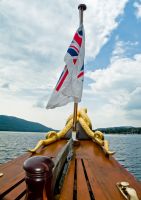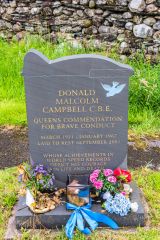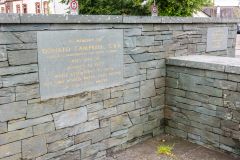
However, it is primarily as a centre for walking that Coniston is rightfully known; the area is known for its superb recreational opportunities, and many of the most popular walks in the Lake District start or finish from Coniston.
Of these, the most popular - and one of the easiest - is the ascent of the Old Man of Coniston, the peak that rises above the village. There are several routes to the top, and the routes are well-trodden and easy to follow, yet still challenging enough to provide an enjoyable walk for even the most experienced fell-walker.
Almost any walk in the area can be combined with other trails to create a much longer circular route. If you wonder if the ascent of the Old Man of Coniston may be too difficult for you, let me assure you that my 7-year old daughter made it, and she is not known for her enthusiasm in tackling challenging exercise! Your reward for the ascent is a wonderful view across Coniston Water.
If walking doesn't appeal to you, you'll probably enjoy taking a boat trip on Coniston Water. Several private companies provide regular boat trips. The Steam Yacht Gondola, operated by the National Trust, is just what it sounds like; a restored 19th-century boat in the shape of a Venetian gondola, powered by a steam engine.

There are also regular tours offered by the Coniston Launch company, with several themed voyages, including a Swallows and Amazon cruise (highly recommended). Coniston Water was the setting for several of Arthur Ransome's popular 'Swallows and Amazons' stories. Keen readers of Ransome's work will recognize Coniston Water landmarks.
On the far shore of Coniston Water, across from the village, is Brantwood, the residence of Victorian writer John Ruskin. The house is preserved much as Ruskin left it, and the superb gardens provide wonderful views across the lake.
The Ruskin Museum in Coniston provides more details of this remarkable man's life and works. It also boasts the original 'Amazon' boat from the Arthur Ransome stories and a special exhibit on Donald Campbell, the world speed record pioneer who was killed on Coniston Water while attempting to set a water speed record. You can see salvaged pieces of Campbell's Bluebird K7 as well as his crash helmet and overalls.
Campbell is buried in the overflow graveyard of St Andrew's Church. For many years his body lay lost in the depths of the lake, but it was later found, and Campbell was buried here, beneath a simple slate gravestone on which is engraved the shape of a bluebird. John Ruskin is buried in the original churchyard under a Celtic-style cross.

A short distance to the north-east of Coniston is Tarn Hows, a famous Victorian beauty spot, where trails lead around a small lake set in a bowl of hills.
Coniston is proud of the fact that it was the very first recipient of the national award for 'Village of the Year', in 1999.













 We've 'tagged' this attraction information to help you find related historic attractions and learn more about major time periods mentioned.
We've 'tagged' this attraction information to help you find related historic attractions and learn more about major time periods mentioned.



